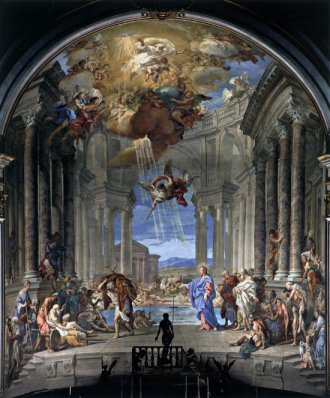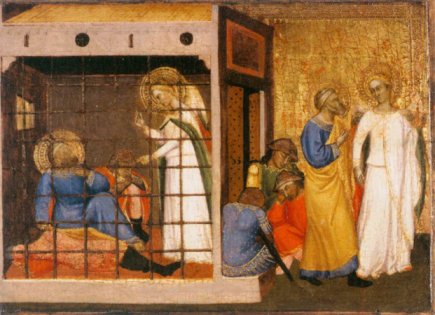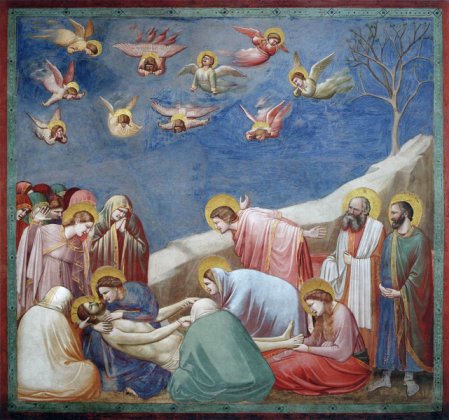|
The Art of Angels - New Testament |
|
|
Authentic biblical scenes involving an angel
include the Annunciation to Mary, the
Annunciation to the Shepherds,
Gethsemane,
and the
Resurrection.
Follow the links to see what I have written about these elsewhere on
this site. The Last Judgment has a section of its own. I will
therefore focus here on two less familiar scenes involving angels. These
scenes are interesting because they involve pro-active angels, rather
than those simply bringing messages. The Pool
of Bethesda.
This narrative comes from the fifth chapter of
John:
Now there is at Jerusalem by the
sheep market a pool, which is called in the Hebrew tongue Bethesda,
having five porches. In these lay a great multitude of impotent folk, of
blind, halt, withered, waiting for the moving of the water. For an angel
went down at a certain season into the pool, and troubled the water:
whosoever then first after the troubling of the water stepped in was
made whole of whatsoever disease he had. And a certain man was there,
which had an infirmity thirty and eight years. When Jesus saw him lie,
and knew that he had been now a long time in that case, he saith unto
him, Wilt thou be made whole? The impotent man answered him, Sir, I have
no man, when the water is troubled, to put me into the pool: but while I
am coming, another steppeth down before me. Jesus saith unto him, Rise,
take up thy bed, and walk. And immediately the man was made whole, and
took up his bed, and walked: and on the same day was the sabbath.
It's an odd story in many ways: the idea that
only the first person to get to the pool would be cured is puzzling; as
the 'impotent man' suggests, the most infirm is the least likely to be
ahead of the crowd. The story is problematic for artists as two separate events are described; the troubling of the pool by the angel - traditionally the archangel Raphael - and Christ's miracle. The usual solution was to include both events. |
|
 Sebastiano Conca Spedale di Santa Maria della Scala, Siena
|
 Paolo Veronese: San Sebastiano, Venice
|
|
The
Dutch Artist Joost Cornelius Droochsloot takes a more ironic, northern
European approach. The characters have seen the angel, but we don't -
presumably it has already gone, and Jesus is yet to arrive. So we see the
mad dash for the pool, with the most infirm left behind. |
|
 |
|
|
Peter's deliverance from prison. This is the
account from Acts chapter 12: 'Now about that time Herod the king
stretched forth his hands to vex certain of the church. And he killed
James the brother of John with the sword. And because he saw it pleased
the Jews, he proceeded further to take Peter also. (Then were the days of
unleavened bread.) And when he had apprehended him, he put him in prison,
and delivered him to four quaternions of soldiers to keep him; intending
after Easter to bring him forth to the people. Peter therefore was kept in
prison: but prayer was made without ceasing of the church unto God for
him. And when Herod would have brought him forth, the same night Peter was
sleeping between two soldiers, bound with two chains: and the keepers
before the door kept the prison. And, behold, the angel of the Lord came
upon him, and a light shined in the prison: and he smote Peter on the
side, and raised him up, saying, Arise up quickly. And his chains fell off
from his hands. And the angel said unto him, Gird thyself, and bind on thy
sandals. And so he did. And he saith unto him, Cast thy garment about
thee, and follow me. And he went out, and followed him; and wist not that
it was true which was done by the angel; but thought he saw a vision. When
they were past the first and the second ward, they came unto the iron gate
that leadeth unto the city; which opened to them of his own accord: and
they went out, and passed on through one street; and forthwith the angel
departed from him. And when Peter was come to himself, he said, Now I know
of a surety, that the Lord hath sent his angel, and hath delivered me out
of the hand of Herod, and from all the expectation of the people of the
Jews.'
This is not the first time that an angel
had been involved in a jailbreak. All of the apostles were freed in Acts
Chapter 5. Chapter 12 is the most dramatic, and the chapter concludes with
another dramatic angelic intervention:
And upon a
set day Herod, arrayed in royal apparel, sat upon his throne, and made an
oration unto them. And the people gave a shout, saying, It is the voice of
a god, and not of a man. And immediately the angel of the Lord smote him,
because he gave not God the glory: and he was eaten of worms, and gave up
the ghost. (V 21 - 23)
This final scene has considerable artistic
possibilities, but they have not been realised; I can find only one image
of the End of Herod; he is not looking at all well. |
|
 Jacopo di Cione: Museum of Art, Philadelphia |
 The end of Herod. Italian, before1093 Benedictine Church, Lambach |
|
|
|
